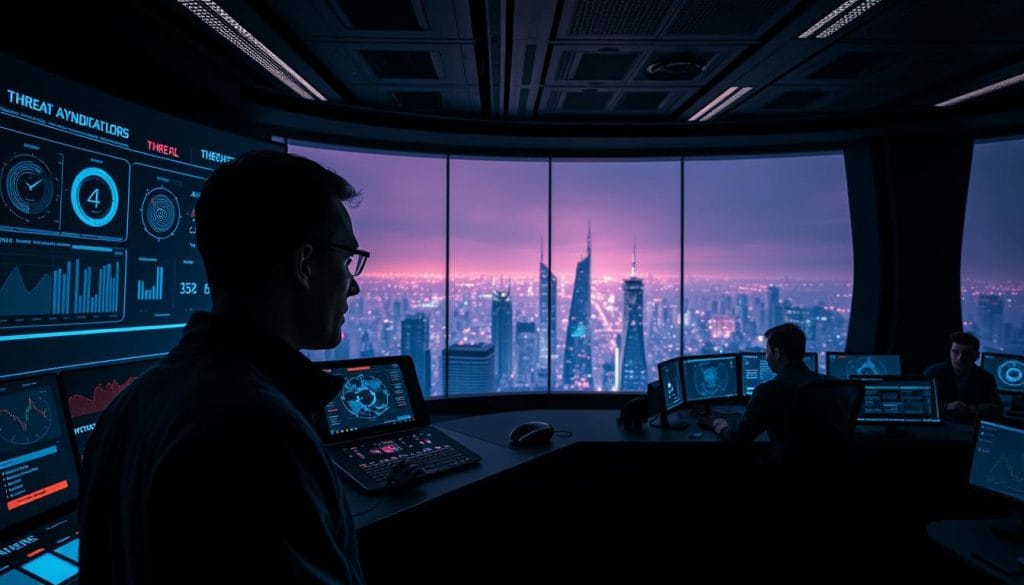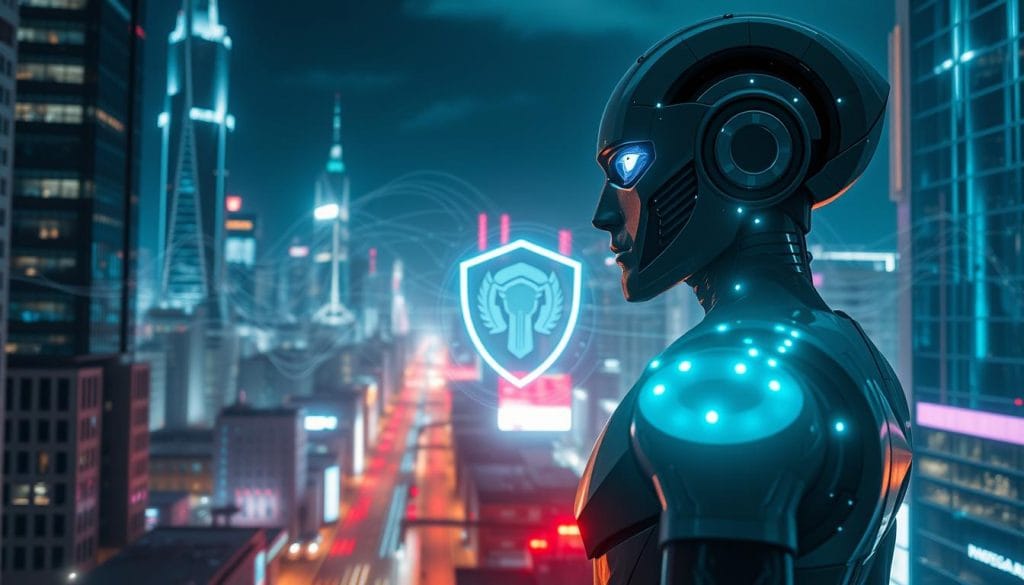AI Cybersecurity: The Future of Threat Detection. Are traditional cybersecurity methods enough to protect our digital world from growing cyber threats?
Traditional defence methods are falling short as threats evolve, and Artificial Intelligence is changing the game with faster, smarter, and more predictive solutions. AI can spot unusual activity, find vulnerabilities, and act quickly, as shown in this article on AI in business.
Key Takeaways
- Cyber threats are becoming more frequent and complex, necessitating advanced security measures.
- Artificial Intelligence is transforming cybersecurity by providing faster, smarter solutions.
- AI-driven systems can detect unusual activity and respond to threats in real time.
- The use of AI in cybersecurity reduces false positives, allowing security teams to focus on genuine issues.
- AI-powered cybersecurity solutions are being adopted across various sectors, including banking and healthcare.
The Evolving Landscape of Digital Threats
Digital threats are changing fast, making old cybersecurity ways less effective, which means companies need new, smarter ways to protect themselves. The world of cybersecurity is getting more complex.
Current Cybersecurity Challenges in the UK and Globally
In 2025, cybersecurity challenges in the UK and globally are becoming increasingly complex due to the rapid adoption of AI, the growing threat of state-sponsored cyber attacks, and the widespread use of connected devices.
Organisations face rising risks from sophisticated phishing campaigns powered by generative AI, ransomware-as-a-service (RaaS) platforms, and deepfake-enabled social engineering attacks. In the UK, businesses are also grappling with evolving regulatory demands, such as compliance with the updated NCSC cybersecurity guidelines and the EU’s NIS2 directive post-Brexit.
Globally, a shortage of skilled cybersecurity professionals continues to strain resources, making it harder for organisations to keep pace with emerging threats and secure critical infrastructure.
The Limitations of Traditional Security Approaches
Traditional cybersecurity methods, such as firewalls, antivirus software, and perimeter-based defences, are increasingly ineffective against modern threats.
These approaches rely on static rules and signature-based detection, making them vulnerable to zero-day exploits, AI-driven attacks, and sophisticated social engineering. Additionally, the rise of cloud computing, remote work, and IoT devices has dissolved the traditional network perimeter, leaving gaps that legacy systems cannot address.
Organisations that are still dependent on outdated security models face higher risks of breaches, emphasising the need for adaptive strategies like Zero Trust, AI-powered threat detection, and continuous monitoring to stay ahead of cybercriminals in 2025.
AI and Cybersecurity: Smarter Threat Detection for a Digital World
AI is changing how companies fight cyber threats. It helps them quickly find dangers, recognise patterns, and predict risks. AI also processes large amounts of data to stop threats before they happen, as explained in this report on AI cybersecurity.
Defining AI-Powered Cybersecurity
AI-powered cybersecurity leverages machine learning (ML) and artificial intelligence to detect, analyse, and respond to threats in real time. Unlike traditional rule-based systems, AI continuously learns from vast datasets, identifying anomalies, predicting attack patterns, and automating incident response.
Key applications include behavioural analytics for detecting insider threats, AI-driven phishing detection, and adaptive authentication systems. In 2025, as cyberattacks grow more sophisticated, AI enables faster threat mitigation, reduces false positives, and enhances proactive defence, making it a cornerstone of modern security strategies.
However, challenges remain, including adversarial AI attacks and ethical concerns around automated decision-making.
How Machine Learning Enhances Threat Detection
Machine learning, a component of AI, learns from data. In cybersecurity, it aids in identifying patterns and anomalies that could indicate threats, which enables companies to respond quickly when dangers arise.

The Role of Behavioural Analytics in Modern Security
Behavioural analytics plays a critical role in modern cybersecurity by monitoring and analysing patterns in user and system behaviour to detect anomalies that may indicate a threat.
Instead of relying solely on known signatures or rules, behavioural analytics uses machine learning to establish a baseline of “normal” activity and flags deviations, such as unusual login times, data access patterns, or file transfers, that could signal insider threats, compromised accounts, or advanced attacks.
This approach enables faster, more accurate threat detection, especially in complex and distributed IT environments, helping organisations respond to potential breaches before significant damage occurs.
How AI Is Transforming Cybersecurity Operations
AI is transforming cybersecurity operations by automating threat detection, streamlining incident response, and enhancing overall situational awareness.
With the ability to process vast amounts of data in real time, AI can identify patterns and anomalies far faster than traditional methods, reducing response times from hours to seconds. It powers tools like predictive analytics, intelligent threat hunting, and automated security orchestration, helping teams detect advanced threats and respond before damage is done.
Additionally, AI reduces analyst workload by filtering false positives and prioritising real threats, enabling more efficient and proactive cybersecurity management in an increasingly complex digital landscape.
Automating Routine Security Tasks
AI is also making cybersecurity better by automating routine tasks like monitoring network traffic and reviewing logs, which are boring and time-consuming, so people can work on more important tasks.
Additionally, automation reduces errors, which are a major cause of security breaches.
Top Cyber Threats AI Can Effectively Combat
AI is changing cybersecurity, as it helps fight against ongoing threats, sophisticated phishing attacks, and other complex risks that are common today.

Advanced Persistent Threats (APTs)
Advanced Persistent Threats (APTs) are long-term, targeted cyber attacks usually carried out by skilled hackers, often backed by governments or large criminal groups. Unlike quick, random attacks, APTs aim to quietly break into a network, stay hidden for a long time, and steal sensitive information or cause damage.
They often use tricks like phishing and unknown software flaws to get in and move through systems. Because they’re so stealthy and complex, APTs are hard to detect and stop with basic security tools.
AI helps by:
- Identifying patterns and anomalies in network traffic
- Detecting and responding to suspicious user behaviour
- Enhancing incident response with predictive analytics
Sophisticated Phishing Attacks
Sophisticated phishing attacks are advanced scams that use carefully crafted emails, websites, or messages to trick individuals into revealing sensitive information like passwords, financial details, or access credentials. Unlike basic phishing, these attacks often appear highly convincing, mimicking trusted brands, using personal information, and even leveraging AI to create realistic content.
Some may bypass traditional security filters and target specific individuals or roles within an organisation (known as spear phishing). These refined techniques make phishing harder to detect and more dangerous for both individuals and businesses.
AI fights these by:
- Checking email content and metadata for phishing
- Spotting phishing email patterns that humans miss
- Using AI to filter out bad emails
Zero-Day Vulnerabilities
Zero-day vulnerabilities are hidden security flaws in software or systems that hackers discover before the developers know about them. Because there’s no fix or patch available yet, these flaws can be used to launch attacks and cause serious damage.
Once the vulnerability is found by the software maker, they rush to fix it—but until then, it’s called a “zero-day” because there are zero days of protection against it. These types of threats are dangerous because they can be exploited without warning.
AI helps by:
- Watching network traffic for odd behaviour
- Guessing where attacks might come from based on past data
- Quickly fixing new vulnerabilities with AI
Insider Threats and Anomalous Behaviour
Insider threats and anomalous behaviour are hard to spot and often come from inside the organisation.
AI can find these by:
- Looking at user behaviour for odd changes
- Watching for strange network activity
- Alerting in real-time to security risks
Using AI to fight these threats makes organisations much safer. It helps protect against many kinds of attacks.
Strategic Approaches to Implement AI in Your Cybersecurity Framework
Using AI in cybersecurity needs a few key steps, and companies must have a plan that covers all parts of their security setup.
1. Assessing Your Organisation’s Security Needs
First, assess your security needs by identifying weak spots, understanding threats, and selecting the right AI tools. For example, if you’re frequently targeted by phishing, you may need AI for email security.
Use cybersecurity insights and threat data to guide your choices. This way, you can focus on solving specific security problems with AI.
2. Integrating AI with Existing Security Infrastructure
Integrating AI with your current security setup is key. Make sure AI tools work well with your systems, like firewalls and SIEM systems.
It’s important to know both your current systems and the AI you’re adding, as you might need to update old systems or get new ones that work better with AI.
3. Training Security Teams on AI Capabilities
It’s vital to train your security team on AI. Teach them how AI can help with threats, how to use AI tools and its limits.
By teaching your team, you can get the most out of AI, which will help strengthen your cybersecurity.
4. Establishing Metrics for AI Security Performance
Setting up metrics for AI performance is important, as you will need to track how well AI is doing in detecting threats and responding quickly.
Check these metrics often, as this helps you improve your AI strategy and keeps your security strong against new threats.
Companies Leading the AI Cybersecurity Revolution
A new wave of companies is changing the cybersecurity world with artificial intelligence. These leaders are creating and using advanced AI to fight cyber threats.
British Innovators in AI Security
The UK has a thriving cybersecurity scene, with many UK companies at the forefront of AI security. Darktrace is one, using AI to quickly spot and act on cyber threats.
Global Leaders Shaping the Industry
Across the globe, companies are also making big moves in AI cybersecurity. Cybereason and Check Point are among the top names, using AI to improve their security services.
Emerging Technologies That Will Shape Tomorrow’s Security
New technologies like quantum computing and blockchain will change cybersecurity. It is important to understand how these technologies can improve security.
| Trend/Challenge | Description | Impact |
|---|---|---|
| AI-Powered Defence Systems | Advanced defence mechanisms using AI | Enhanced threat detection |
| Ethical Considerations | Concerns about data privacy and AI bias | Need for transparent AI systems |
| Regulatory Developments | Frameworks governing AI use in cybersecurity | Standardization and compliance |
| Emerging Technologies | Technologies like quantum computing and blockchain | Potential to revolutionize cybersecurity |
Conclusion: Embracing AI as a Core Component of Modern Cybersecurity
As cyber threats grow in complexity and scale, traditional security measures alone are no longer sufficient. Embracing AI as a core component of modern cybersecurity enables organisations to detect anomalies, predict attacks, and respond in real time with unmatched efficiency.
By leveraging machine learning and automation, businesses can stay ahead of adversaries, reduce response times, and enhance threat intelligence; however, successful integration requires ethical considerations, human oversight, and continuous adaptation to evolving risks.
The future of cybersecurity lies in a symbiotic relationship between AI and human expertise, harnessing innovation to build resilient, proactive defences in an increasingly digital world.


